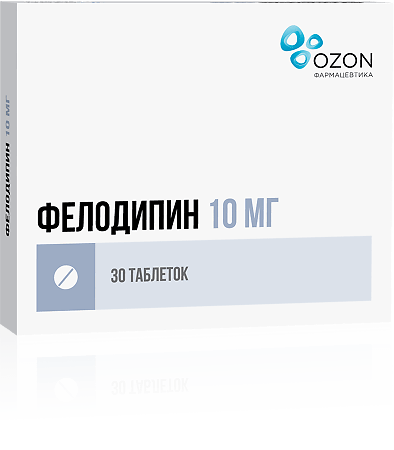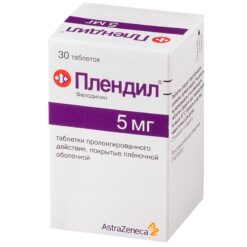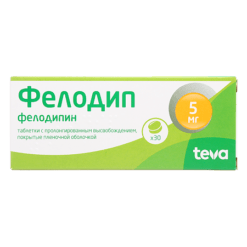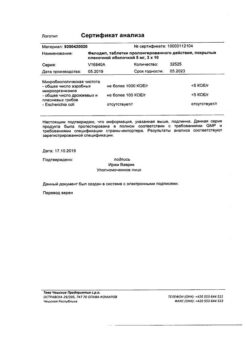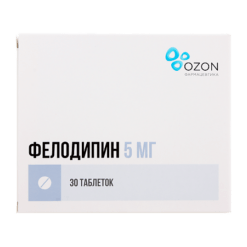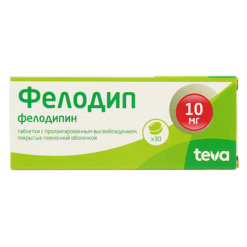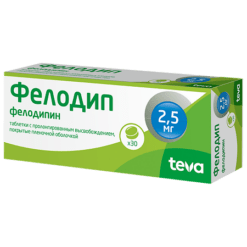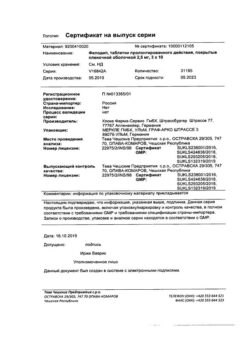No products in the cart.
Felodipine, 10 mg 30 pcs
€16.25 €14.09
Description
A class II selective calcium channel blocker from the group of dihydropyridine derivatives. Like other dihydropyridine derivatives, felodipine has significantly higher affinity for calcium channels of smooth muscle cells of arterial vessels than for calcium channels of cardiomyocytes.
Blocking calcium channels and disrupting the flow of calcium ions into the smooth muscle cells of arterial vessels, causes their dilation, reduces PPS and lowers BP. It reduces the afterload on the heart.
It has practically no inhibitory effect on myocardial contractility and conduction, causes moderately pronounced reflex tachycardia. It increases coronary blood flow.
Decreases intake of extracellular calcium into cardiomyocytes and smooth muscle cells of coronary and peripheral arteries; in high doses it reduces the release of calcium ions from intracellular depots. Reduces the number of functioning channels without affecting the time of their activation, inactivation and recovery.
Disassociates the processes of excitation and contraction in the myocardium mediated by tropomyosin and troponin and in vascular smooth muscle mediated by calmodulin.
In therapeutic doses it normalizes the transmembrane calcium flow disturbed in a number of pathological conditions, especially in arterial hypertension. It reduces BP due to vasodilatation and decreases RPS. It does not affect venous tone and adrenergic vasomotor innervation, therefore it does not cause orthostatic hypotension.
It has a dose-dependent anti-ischemic effect. It increases coronary blood flow, improves blood supply of ischemic zones of myocardium without development of “bypass” phenomenon, activates functioning of collaterals, protects from reperfusion complications, slightly increases HR. By dilating the peripheral arteries, it reduces the afterload.
It has almost no effect on the sinoatrial and AV nodes. Virtually no negative inotropic effect (the reflex increase in heart rate in response to vasodilation masks the negative inotropic effect).
It increases renal blood flow, has a moderate natriuretic and diuretic effect.
The action begins after 2-5 hours and lasts for 24 hours. The severity of the effect correlates with the dose and plasma concentration.
Pharmacokinetics
Indications
Indications
Arterial hypertension, angina pectoris (if beta-blockers and nitrates are ineffective), Raynaud’s syndrome (as symptomatic therapy).
Pharmacological effect
Pharmacological effect
Selective class II calcium channel blocker from the group of dihydropyridine derivatives. Like other dihydropyridine derivatives, felodipine has a significantly higher affinity for the calcium channels of arterial smooth muscle cells than for the calcium channels of cardiomyocytes.
By blocking calcium channels and disrupting the flow of calcium ions into the smooth muscle cells of arterial vessels, it causes their expansion, reduces peripheral vascular resistance and lowers blood pressure. Reduces afterload on the heart.
It has virtually no inhibitory effect on myocardial contractility and conductivity and causes moderate reflex tachycardia. Increases coronary blood flow.
Reduces the flow of extracellular calcium into cardiomyocytes and smooth muscle cells of the coronary and peripheral arteries; in high doses reduces the release of calcium ions from intracellular stores. Reduces the number of functioning channels without affecting the time of their activation, inactivation and recovery.
It uncouples the processes of excitation and contraction in the myocardium, mediated by tropomyosin and troponin, and in vascular smooth muscles, mediated by calmodulin.
In therapeutic doses, it normalizes the transmembrane calcium current, which is disturbed in a number of pathological conditions, primarily arterial hypertension. Reduces blood pressure due to vasodilation, reducing peripheral vascular resistance. It does not affect venous tone and adrenergic vasomotor innervation, and therefore does not cause orthostatic hypotension.
Has a dose-dependent anti-ischemic effect. Strengthens coronary blood flow, improves blood supply to ischemic areas of the myocardium without developing the “steal” phenomenon, activates the functioning of collaterals, protects against complications of reperfusion, and slightly increases heart rate. By dilating peripheral arteries, it reduces afterload.
Almost no effect on the sinoatrial and AV nodes. It has virtually no negative inotropic effect (a reflex increase in heart rate in response to vasodilation masks the negative inotropic effect).
Increases renal blood flow and has a moderate natriuretic and diuretic effect.
The action begins within 2-5 hours and continues for 24 hours. The severity of the effect correlates with the dose and plasma concentration.
Pharmacokinetics
Special instructions
Special instructions
Use with caution in patients with heart failure, blood pressure lability, renal failure, heart failure after myocardial infarction.
When used in patients with angina pectoris, it should be taken into account that in rare cases, felodipine can cause severe arterial hypotension, which leads to myocardial ischemia.
Active ingredient
Active ingredient
Felodipin
Composition
Composition
1 tablet contains the active substance: felodipine 10 mg.
Pregnancy
Pregnancy
Contraindicated for use during pregnancy (including possible).
Use in children
Contraindicated in people under 18 years of age.
Contraindications
Contraindications
Acute myocardial infarction, decompensated chronic heart failure, age under 18 years, pregnancy, women of childbearing age with a high probability of pregnancy, hypersensitivity to felodipine.
Side Effects
Side Effects
From the cardiovascular system: flushes of blood to the facial skin, accompanied by facial hyperemia, tachycardia, swelling in the ankle joint (as a result of precapillary vasodilation), fainting, extrasystole, severe arterial hypotension, accompanied by reflex tachycardia and worsening angina, leukocytoclastic vasculitis.
From the side of the central nervous system: headache, dizziness, feeling of fatigue, paresthesia.
From the digestive system: nausea, abdominal pain, vomiting, increased activity of liver transaminases, hyperplasia of the gums, tongue mucosa, gingivitis.
From the musculoskeletal system: rarely – arthralgia, myalgia.
Allergic reactions: skin rash, itching, urticaria, angioedema of the lips or tongue, photosensitivity reaction.
Other: impotence/sexual dysfunction, frequent urination, fever, hyperglycemia.
Interaction
Interaction
When used simultaneously with inhibitors of microsomal liver enzymes, it is possible to increase the concentration of felodipine in the blood plasma.
It is possible to reduce the concentration of felodipine in the blood plasma due to an increase in the intensity of its metabolism in the liver under the influence of carbamazepine, phenytoin and phenobarbital (which are inducers of microsomal liver enzymes) and accelerated excretion from the body.
When used simultaneously with digoxin, an increase in the concentration of digoxin in the blood plasma is possible.
When used simultaneously with itraconazole and ketoconazole, the metabolism of felodipine in the liver slows down, which leads to an increase in the concentration of felodipine in the blood plasma and an increased risk of side effects.
When used simultaneously with erythromycin, the bioavailability of felodipine increases. There is a report of increased therapeutic and side effects of felodipine in a patient receiving erythromycin.
Increases the bioavailability of propranolol. When used simultaneously with beta-blockers, the risk of developing chronic heart failure increases.
A decrease in the antihypertensive effect is observed with the simultaneous use of felodipine with NSAIDs, corticosteroids (sodium retention and blockade of prostaglandin synthesis by the kidneys) and estrogens (sodium retention), calcium preparations; The antihypertensive effect is enhanced when used simultaneously with inhaled anesthetics, beta-blockers, alpha-blockers, sympathomimetics and other antihypertensive drugs.
Drugs that cause QT prolongation potentiate the negative inotropic effect and may increase the risk of significant QT prolongation.
Manufacturer
Manufacturer
Ozon, Russia
Additional information
| Manufacturer | Ozon, Russia |
|---|---|
| Medication form | sustained release tablets |
| Brand | Ozon |
Other forms…
Related products
Buy Felodipine, 10 mg 30 pcs with delivery to USA, UK, Europe and over 120 other countries.

